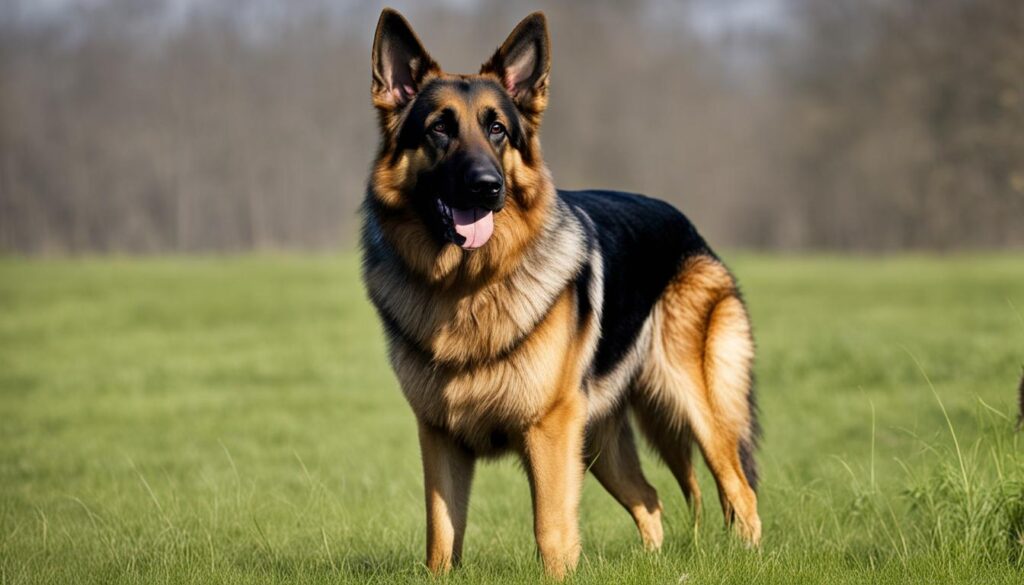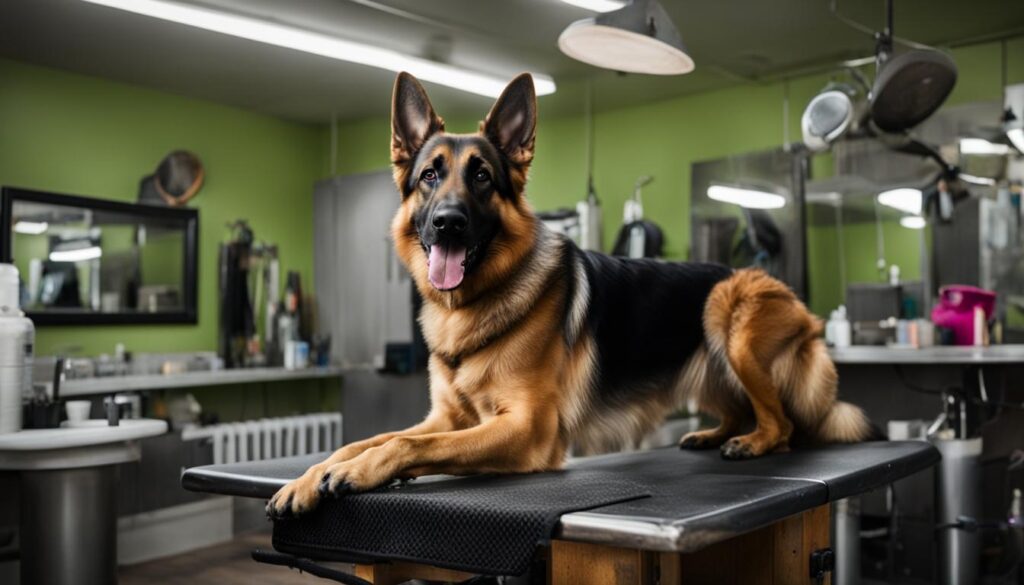Are you curious about the size of a German Shepherd? Well, you’ve come to the right place! As a proud German Shepherd owner myself, I’ve done extensive research to uncover the facts about their size and growth. In this article, I will share with you everything you need to know about the average size, maximum size, and growth patterns of these majestic dogs.
Key Takeaways:
- The average height of a male German Shepherd is between 24-26 inches, while females measure between 22-24 inches.
- Male German Shepherds typically weigh between 66-88 pounds, while females weigh between 49-71 pounds.
- Genetics, diet, exercise, and overall health play a role in determining a German Shepherd’s size.
- Understanding the typical size range is important for proper care and expectations.
- Stay tuned as we dive deeper into the various factors that can affect the size of a German Shepherd!
The Versatile German Shepherd: Characteristics and Uses
German Shepherds possess a unique set of characteristics that make them highly sought after for various roles and tasks. Their exceptional intelligence, confidence, and courage make them ideal candidates for police work, military service, and search and rescue operations. These qualities also make them excellent therapy dogs, providing comfort and companionship to those in need.
Aside from their working abilities, German Shepherds are known for their unwavering loyalty and devotion to their families. They form strong bonds with their owners and are protective of their loved ones, making them excellent family pets. Their versatility extends beyond their physical capabilities, as they are also known for their adaptability and trainability.
The history of the German Shepherd breed is rich and fascinating. Originating in Germany in the late 19th century, German Shepherds were initially bred for herding sheep. However, their exceptional skills and intelligence quickly caught the attention of the military and law enforcement. Today, they are one of the most popular and recognizable dog breeds, thanks in part to famous canine stars like Strongheart and Rin Tin Tin.
Temperament and Characteristics
German Shepherds are known for their balanced temperament and steady demeanor. They are confident dogs with a strong sense of purpose, always eager to learn and work. Their keen sense of smell and ability to focus make them excellent candidates for tasks such as drug detection, tracking, and search and rescue.
In addition to their intelligence and working abilities, German Shepherds are also known for their loyalty and affection towards their owners. They thrive on human companionship and enjoy being part of a family. However, they can be reserved with strangers, making them excellent guard dogs.
The German Shepherd’s physical appearance matches their impressive temperament. They have a powerful and muscular build, with a strong and agile body. Their double coat provides protection from various weather conditions, and their erect ears and alert expression give them an intelligent and attentive appearance.
Understanding German Shepherd Physical Characteristics
When it comes to physical characteristics, German Shepherds have distinct features that set them apart. One notable attribute is their double coat, which consists of a thick undercoat and a finer, sometimes wavy, outercoat. This double coat helps to protect them from varying weather conditions and provides insulation.
In terms of height, German Shepherds typically range between 22 and 26 inches. However, it’s important to note that individual variations can occur. As for weight, males generally weigh between 66 and 88 pounds, while females weigh between 49 and 71 pounds. These numbers provide a general guideline, but it’s important to remember that every dog is unique.
When it comes to body structure, German Shepherds have a strong and athletic build. Their bodies are long in proportion to their height, and they have smooth, graceful curves rather than harsh angles. This structure enables them to be agile and powerful, making them well-suited for various tasks and activities.

Double Coat: Protection and Adaptability
The double coat of a German Shepherd serves as more than just an aesthetic feature. It provides protection against the elements, helping them adapt to various climates and environments. The thick undercoat helps to insulate their bodies in cold weather, while the outercoat acts as a barrier against dirt, water, and UV rays.
This double coat also plays a role in shedding, which can vary depending on the season. German Shepherds typically shed moderately throughout the year, with heavier shedding occurring during seasonal coat changes. Regular brushing is necessary to remove loose hair and prevent matting, keeping their coats healthy and shiny.
In conclusion, understanding the physical characteristics of German Shepherds is crucial for their care and well-being. Their double coat, height, weight, and body structure all contribute to their unique appearance and abilities. By embracing and appreciating these characteristics, we can provide the best possible care for these loyal and remarkable dogs.
Exercise and Training for a Healthy German Shepherd
Proper exercise and training are essential for maintaining the health and well-being of a German Shepherd. These intelligent and active dogs require regular physical activity to burn off energy and stay in peak condition. Not only does exercise help them maintain a healthy weight, but it also keeps their muscles strong and their mind sharp.
German Shepherds are known for their high intelligence and trainability. They thrive on mental stimulation and enjoy learning new tasks and commands. Training sessions should be structured, consistent, and based on positive reinforcement techniques. This breed responds well to rewards such as treats, praise, and playtime, making training an enjoyable experience for both dog and owner.
One aspect of exercise that German Shepherds particularly enjoy is playtime. They have a natural prey drive and love engaging in games that allow them to use their instincts. Fetch, tug-of-war, and hide-and-seek are all great options for interactive play. These activities not only provide physical exercise but also stimulate the dog’s mind, helping to prevent boredom and destructive behaviors.
Creating a Balanced Exercise Routine
When designing an exercise routine for your German Shepherd, it’s important to consider their age, health, and individual needs. Puppies have different exercise requirements than adult dogs, and senior German Shepherds may have reduced mobility and stamina. A balanced routine should include a mix of aerobic exercise, such as brisk walks or jogging, and strength-building activities like agility training or swimming. Aim for at least 30-60 minutes of exercise per day, divided into multiple sessions.
Remember to always adjust the intensity and duration of exercise based on your dog’s abilities and any underlying health conditions. It’s essential to consult with your veterinarian before starting any new exercise program for your German Shepherd to ensure it is appropriate for their specific needs.
Grooming a German Shepherd
Proper grooming is essential for keeping your German Shepherd looking and feeling their best. With their double coat, they require regular brushing to prevent matting and reduce shedding. Brushing also helps distribute natural oils and stimulate the skin, promoting a healthy coat. Aim to brush your German Shepherd at least once a week, and more frequently during shedding seasons.
In addition to regular brushing, occasional baths are necessary to keep your German Shepherd clean and fresh. Use a gentle dog shampoo and make sure to rinse thoroughly to remove all soap residue. Avoid over-bathing, as it can strip the coat of its natural oils and lead to dry skin. Remember to trim your German Shepherd’s nails regularly and check their ears for any signs of infection.
Grooming Tips:
- Invest in a quality grooming brush specifically designed for German Shepherds to effectively remove loose hair.
- Consider using a de-shedding tool during heavy shedding seasons to help manage the amount of hair your German Shepherd sheds.
- If your German Shepherd gets dirty between baths, use a damp cloth to wipe down their coat and paws.
- Ensure your German Shepherd’s coat is completely dry after bathing before letting them outside to prevent them from getting chilled.
Grooming is not only important for the appearance of your German Shepherd, but it also helps maintain their overall health. Regular grooming sessions provide an opportunity to check for any skin issues, parasites, or abnormalities. It’s also a bonding experience that allows you to spend quality time with your furry companion. By incorporating grooming into your routine, you’ll help keep your German Shepherd comfortable, happy, and looking their best.

Proper Nutrition for a Growing German Shepherd
Proper nutrition plays a vital role in the growth and development of a German Shepherd, from puppyhood to adulthood. It is important to provide a balanced diet that meets their specific nutritional needs at each stage of life. For German Shepherd puppies, a diet rich in high-quality protein and healthy fats is essential for their rapid growth and development. Look for commercial dog food formulated for large breed puppies, as it contains the right blend of nutrients to support their bone and muscle growth.
As your German Shepherd transitions into adulthood, their nutritional needs may change. It is important to adjust their diet accordingly to prevent weight gain or deficiencies. Adult German Shepherds require a well-rounded diet that includes lean protein, healthy fats, carbohydrates, and a variety of fruits and vegetables. Avoid feeding them table scraps or excessive treats, as it can lead to weight gain and digestive issues.
Feeding Guidelines for German Shepherds
Feeding guidelines can provide a general starting point, but it is essential to monitor your German Shepherd’s body condition and adjust their portion sizes accordingly. Typically, adult German Shepherds should be fed twice a day, with meals divided into equal portions. Avoid free-feeding, as it can lead to overeating and obesity. Always provide fresh water and avoid sudden changes in diet, as it can cause digestive upset.
Consulting with a veterinarian is recommended to ensure your German Shepherd is receiving the appropriate diet and nutrition. They can also provide guidance on any specific dietary needs or restrictions your dog may have. Remember, a healthy diet is key to maintaining your German Shepherd’s overall well-being and promoting their long-term health.
Health and Aging in German Shepherds
As German Shepherds age, it’s important to pay close attention to their health to ensure they can live happy and comfortable lives. The average lifespan of a German Shepherd is around 7-10 years, although individual dogs may vary. Regular veterinary check-ups are crucial for monitoring their overall health and detecting any potential issues early on. German Shepherd lifespan can be influenced by factors such as genetics, diet, exercise, and overall care.
Common health issues in German Shepherds
German Shepherds are prone to certain health risks, and it’s important to be aware of these to provide proper care. One common health issue in the breed is hip and elbow dysplasia, which can cause pain, lameness, and mobility problems. Degenerative myelopathy, a progressive neurological disorder, is also prevalent in German Shepherds and can lead to hind limb weakness and paralysis. Back and joint problems, such as intervertebral disc disease, can also occur. Regular exercise, a balanced diet, and maintaining a healthy weight can help minimize these health risks.
German Shepherd senior care
As German Shepherds enter their senior years, their care needs may change. They may experience age-related issues such as arthritis, vision and hearing loss, dental problems, and cognitive decline. Providing a comfortable environment, regular exercise tailored to their capabilities, and a nutritious diet can help support their overall well-being. Mental stimulation, such as puzzle toys and interactive games, can help keep their minds sharp. It’s important to adjust their care routine and consult with a veterinarian for guidance on senior-specific health monitoring and support.
Solid Black German Shepherds: Rare Beauties
When it comes to German Shepherds, the breed’s standard colors of black and tan, black and red, or sable are widely recognized. However, there is a rarer color variation that is highly sought after by enthusiasts – the solid black German Shepherd. These majestic dogs possess a striking all-black coat that sets them apart from their more common counterparts.
Genetics play a significant role in determining the appearance of a solid black German Shepherd. Breeders who specialize in this color variation carefully select breeding pairs to produce solid black puppies. While black German Shepherds share the same characteristics and temperaments as other members of the breed, their unique coat color adds an extra touch of elegance and allure.
Black German Shepherds are known for their intelligence, loyalty, and versatility, making them exceptional companions, working dogs, and family pets. Their dark coat can highlight their confident and regal presence, making them truly stand out in any setting. If you’re lucky enough to own a solid black German Shepherd, you’ll have a beautiful and rare gem that will turn heads wherever you go.
Factors Affecting German Shepherd Size
When it comes to the size of a German Shepherd, several factors can contribute to variations in height and weight. One major influence is genetics, as inherited traits can determine the size of a dog. Breeders carefully select parent dogs with desired size characteristics to produce puppies that meet the breed standards. Additionally, diet and exercise play a crucial role in the growth and development of a German Shepherd. Providing a balanced diet and regular exercise can support healthy growth and prevent obesity, which can impact the overall size of the dog.
Health also plays a significant role in the size of a German Shepherd. Underlying health conditions or parasite infections can affect a dog’s growth, resulting in variations in size. Regular veterinary check-ups and proper healthcare can help ensure that any health issues are addressed promptly, allowing the dog to reach its full potential size.
Furthermore, different subtype lines within the German Shepherd breed may naturally vary in size. Working lines, show lines, and pet lines each have their own characteristics, including differences in size. Working lines might tend to have a more compact and muscular build, while show lines may have a larger frame and stature. It’s essential to consider these factors when choosing a German Shepherd, as size preferences may vary depending on the intended purpose of the dog.
Conclusion
In conclusion, the size of a German Shepherd can vary depending on various factors. On average, males typically measure between 24-26 inches in height and weigh between 66-88 pounds, while females are slightly smaller, measuring between 22-24 inches in height and weighing between 49-71 pounds.
Genetics play a significant role in determining the size of a German Shepherd, but other factors such as diet, exercise, and overall health also contribute. It’s important to understand the average size range for this breed to ensure proper care and manage expectations.
By considering these factors and providing appropriate care, you can support the optimal growth and development of your German Shepherd. Remember, every German Shepherd is unique, and individual variations in size are normal. Embrace the diversity within this beloved breed and enjoy the journey of raising a happy and healthy German Shepherd.
FAQ
How big does a German Shepherd get?
The average height for males is between 24-26 inches and for females between 22-24 inches. The weight range is typically between 66-88 pounds for males and 49-71 pounds for females.
What are the characteristics and uses of German Shepherds?
German Shepherds are known for their confidence, courage, intelligence, and keen sense of smell. They are well-suited for roles such as police work, military service, search and rescue, and therapy work. They also make excellent family pets.
What are the physical characteristics of German Shepherds?
German Shepherds have a double coat consisting of a thick undercoat and a finer, sometimes wavy outercoat. They have a long body in proportion to their height, which typically ranges between 22 and 26 inches. The weight of a German Shepherd can vary depending on the individual.
How much exercise and training do German Shepherds need?
German Shepherds are highly active dogs that require regular physical exercise and mental stimulation. They have high intelligence and are easily trainable. A structured exercise routine and consistent training are essential for keeping a German Shepherd happy and well-behaved.
What is the grooming requirement for German Shepherds?
German Shepherds have a moderate grooming requirement due to their double coat, which sheds moderately throughout the year and more heavily during seasonal coat changes. Regular brushing is necessary to remove loose hair and prevent matting. They only require occasional baths. Nail trimming and dental care are important as well.
What is the proper nutrition for a growing German Shepherd?
Puppies require a diet rich in protein and fats to support their rapid growth, while adult German Shepherds need a well-rounded diet to maintain a healthy weight and muscle mass. High-quality commercial dog food formulated for large breed puppies is recommended, and portion control should be practiced to prevent overfeeding.
What are the common health issues in German Shepherds?
German Shepherds can be prone to health issues such as hip and elbow dysplasia, degenerative myelopathy, and back and joint problems. Regular veterinary check-ups are important for monitoring their health and detecting any potential issues.
Are solid black German Shepherds a different breed?
Solid black German Shepherds are a rarer color variation within the breed. They follow the same breed standards as other German Shepherds and have the same characteristics such as intelligence, trainability, and a strong, athletic build.
What factors affect the size of a German Shepherd?
Various factors, such as genetics, diet, exercise, health, and breed subtype, can influence the size of a German Shepherd.
What is the conclusion about German Shepherd size?
The size of a German Shepherd can vary, but the average height for males is between 24-26 inches and for females between 22-24 inches. The weight range is typically between 66-88 pounds for males and 49-71 pounds for females. Understanding these factors and providing proper care can help ensure the optimal growth and development of this beloved breed.



